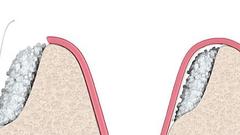Obviously, not all patients are built the same, nor are all areas of the mouth. For theses reasons, we may need adjunctive surgical procedures to maximize the final results.
With the goal being to replace teeth in an esthetic and functional manner, we begin with the end in mind. Placing dental implants may require additional procedures such as sinus augmentation (sinus lift) or bone grafting. Today we have many different sizes of dental implants that we didn't have in the past and this, in certain situations, makes the need for additional procedures unnecessary.
Sinus augmentation is a procedure which we utilize in the back area of the top jaw to create bone in the floor of the sinus. There are two main methods to achieve this. The choice depends on the amount of natural bone thickness a patient has. By creating more bone, we will then have more options in the size and position of the implant placement.
Guided bone regeneration is a technique whereby we build up missing bone. Following surgical guidelines and principles, this is made possible by understanding the biology of the healing process of the mouth. For example, tissue grows very quickly whereby bone grows about one millimeter a month. Once the bone is rebuilt, we are then able to place the implants.
The resorption of bone following dental extractions may lead to a significant problem in implant and restorative dentistry. Ridge preservation is a technique whereby the socket where the tooth is removed is grafted with bone at the time of extraction to reduce the amount of bone loss.
Sometimes, tooth extractions are recommended in the placement of dental implants. For instance, if a patient suffers from gum disease, also known as periodontitis, then the best option can be to remove the teeth and replace them with dental implants. It is another example of taking a step backwards to go forwards. It is well documented in the dental literature that just because a patient has had gum disease with their natural teeth doesn't mean they will also have gum disease with their implants.

Sinus Augmentation
When bone is added in a surgical manner, the upper jaw in the premolar and molar areas of the mouth, it is termed a sinus lift. During this procedure, the sinus membrane will be gently lifted, and bone graft material is then filled into the space created.

Bone Regeneration
Bone that has been lost around missing teeth may be replaced by bone regeneration. In this procedure, the gingival tissue (gum) is elevated and the area is cleaned to remove bacteria. Membranes and bone grafts may be used to create the natural regrowth of bone tissue. This procedure may be needed prior to the placement of dental implants.

Ridge Preservation
Another way to regenerate bone is by utilizing ridge preservation. This procedure involves the placement of bone grafting material into empty tooth sockets where teeth have been removed in order to maintain or rebuild bone.

Tooth Extractions
Our practice performs extractions in our office, whether it is a wisdom tooth or simply a tooth that can't be saved by restorative procedures. The area will be frozen with local anesthesia to ensure your comfort during the extraction.
 Skip site navigation
Skip site navigation
